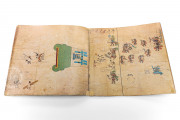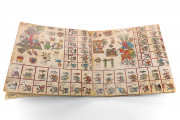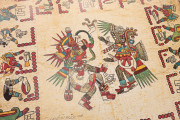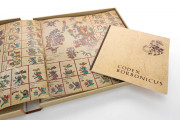Created in the Valley of Mexico in the 1520s, the Codex Borbonicus is a guide to understanding how time was perceived and described by preconquest Aztecs. It is magnificently illustrated using the colors and distinctive pictographic style of Nahua manuscripts. Especially well known for its illustration of the New Fire Ceremony, it boasts an array of representations of ritual objects, deities, deity impersonators, ceremonies, and structures. It is a remarkable example of postconquest indigenous peoples' dedication to the use of traditional methods to depict their worldview.
Despite its nickname, the Codex Borbonicus is not formed of nested sheets folded and sewn at the spine. It is rather a screenfold, with its panels folded accordion style, a traditional format for books of the pre-Columbian Americas. The support is amate paper (made from the bark of the fig tree), which was coated with a thin layer of plaster to receive painting on the obverse. Its thirty-six folios (of an original forty) open out to a length of over fourteen meters.
Pictographs Describe Spiritual Practices
The manuscript's painter-scribes, or tlacuilos, were deeply versed in their subject matter. They worked with a variety of mineral, insect, and plant pigments—including cochineal—to create a full range of turquoise, green, red, and yellow to create their representations of deities, deity impersonators, and ceremonies. Black outlines make the richly colored pictographs stand out against the white plaster background.
The manuscript comprises four sections. The first is devoted to the Aztec calendar intended to aid in divination. There follows a short segment on the origin of time. The next major section treats the annual ceremonies of the solar year, which is followed by representations of the year signs.
Variety in Presentation
The calendar (fols. 3-20, beginning in medias res) is extremely orderly in its presentation. Each page presents one or more large, ornately dressed deities performing a ritual. Along the right and lower edges of each panel, pairs of boxes present the days of each thirteen-day cycle, with each day represented by a number, a night lord, a day lord, and a flying creature.
The calendar is followed by a pair of panels (fols. 21-22) that highlight the deities Oxomoco and Cipactonal (purported inventors of the calendar) and Quetzalcoatl and Tezcatlipoca (associated closely with the calendar). Each pair of gods is surrounded by the Lords of the Night.
The annual ceremonies are presented over fourteen folios (fols. 23-36), with each ceremony dedicated to a deity representing a social or agricultural concept or process. The presentation is less rigid than that of the calendar, with some scenes extending across panel folds. Included in this section is an image of the New Fire Ceremony of 1507 (fol. 54), which marked the transition from one fifty-two-year solar cycle to the next. The manuscript's final panels (fols. 37-38, incomplete) show year signs.
Minimal Textual Content
The textual content of the Codex Borbonicus is restricted to labels and short glosses in Spanish. It seems that at times spaces were left by the painter-scribes for the inscriptions to be added, but at times they seem more haphazard.
A Surprising Early Description
The manuscript was described by William Robertson (1721-1793) in the 2nd edition of his The History of America (1796) as being in the library at El Escorial. At that time, it was still complete with forty folios. Robertson, who reports the screenfold's contents in some detail, credits Robert Darley Waddilove (1736-1828), chaplain to the embassy of Great Britain in Madrid from 1771 to 1779, with having brought the manuscript to his attention.
The screenfold probably found its way to France in the Napoleonic period. In May 1826, it was purchased for the library of the Chambre des députés (the lower house of the French Parliament). It takes its name from the Palais Bourbon, the meeting place of the Chambre des députés (and now its successor, the Assemblée nationale).
We have 1 facsimile edition of the manuscript "Codex Borbonicus": Codex Borbonicus facsimile edition, published by Akademische Druck- u. Verlagsanstalt (ADEVA), 1974
Request Info / Price






















